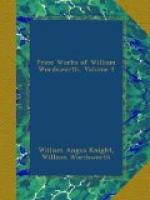To begin, then, with the main outlines of the country;—I know not how to give the reader a distinct image of these more readily, than by requesting him to place himself with me, in imagination, upon some given point; let it be the top of either of the mountains, Great Gavel, or Scawfell; or, rather, let us suppose our station to be a cloud hanging midway between those two mountains, at not more than half a mile’s distance from the summit of each, and not many yards above their highest elevation; we shall then see stretched at our feet a number of vallies, not fewer than eight, diverging from the point, on which we are supposed to stand, like spokes from the nave of a wheel. First, we note, lying to the south-east, the vale of Langdale,[50] which will conduct the eye to the long lake of Winandermere, stretched nearly to the sea; or rather to the sands of the vast bay of Morcamb, serving here for the rim of this imaginary wheel;—let us trace it in a direction from the south-east towards the south, and we shall next fix our eyes upon the vale of Coniston, running up likewise from the sea, but not (as all the other vallies do) to the nave of the wheel, and therefore it may be not inaptly represented as a broken spoke sticking in the rim. Looking forth again, with an inclination towards the west, we see immediately at our feet the vale of Duddon, in which is no lake, but a copious stream, winding among fields, rocks, and mountains, and terminating its course in the sands of Duddon. The fourth vale, next to be observed, viz. that of the Esk, is of the same general character as the last, yet beautifully discriminated from it by peculiar features. Its stream passes under the woody steep upon which stands Muncaster Castle, the ancient seat of the Penningtons, and after forming a short and narrow aestuary enters the sea below the small town of Ravenglass. Next, almost due west, look down into, and along the deep valley of Wastdale, with its little chapel and half a dozen neat dwellings scattered upon a plain of meadow and corn-ground intersected with stone walls apparently innumerable, like a large piece of lawless patch-work, or an array of mathematical figures, such as in the ancient schools of geometry might have been sportively and fantastically traced out upon sand. Beyond this little fertile plain lies, within a bed of steep mountains, the long, narrow, stern, and desolate lake of Wastdale; and, beyond this, a dusky tract of level ground conducts the eye to the Irish Sea. The stream that issues from Wast-water is named the Irt, and falls into the aestuary of the river Esk. Next comes in view Ennerdale, with its lake of bold and somewhat savage shores. Its stream, the Ehen or Enna, flowing through a soft and fertile country, passes the town of Egremont, and the ruins of the castle,—then, seeming, like the other rivers, to break through the barrier of sand thrown up by the winds on this tempestuous coast, enters the Irish Sea. The vale of Buttermere, with the lake and




